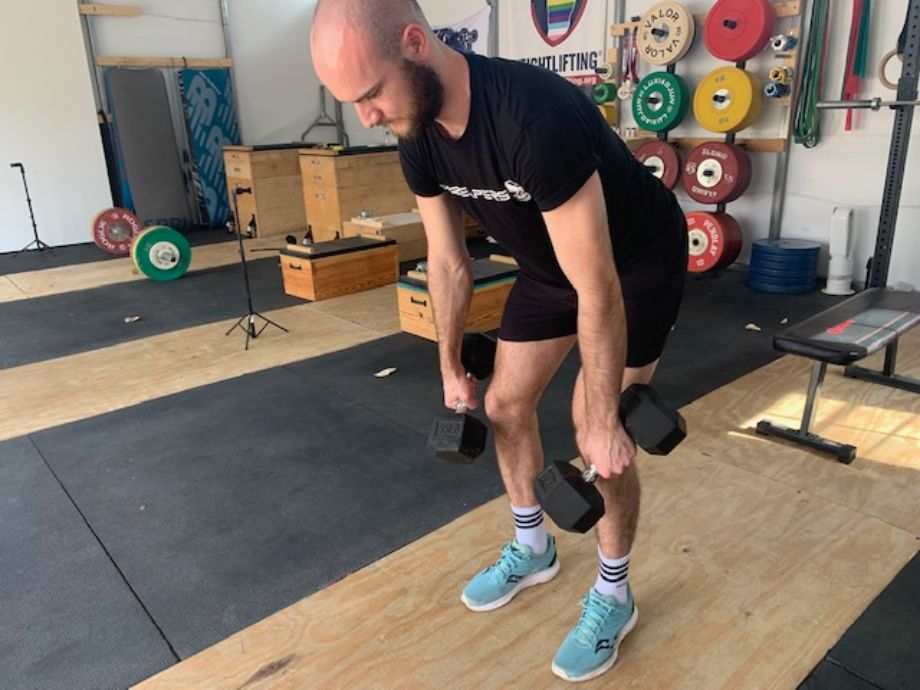We test and review fitness products based on an independent, multi-point methodology. If you use our links to purchase something, we may earn a commission. Read our disclosures.
You don’t need to be a bodybuilder to know what a bicep curl is. Some exercises need no introduction, and thousands of people are regularly banging out sets on their path to muscle growth, weight loss, or whatever other goals they might have in the gym.
We would never undermine tried-and-true gym staples like the bench press, but only sticking to the same old stuff leaves out a plethora of perfectly great alternatives, variations, and totally new exercises that could revamp your regimen and keep things fresh.
Better yet, some of these exercises only require a single dumbbell. That’s it. One and done.
Here are our picks for the most underrated dumbbell exercises to improve your workout routine now. What are you waiting for? Let’s get it, fitness fam!
12 Underrated Dumbbell Exercises You Need to Try
All you need for these exercises are one or two dumbbells and you’re golden. We recommend going light when first trying any new movement and increasing the weight as you gain proficiency.
Renegade Row
Why It’s Great: Renegade rows are both convenient and challenging, allowing you to get a full-body exercise in one succinct movement.
Muscles Worked: Performing the row portion of movement targets your triceps and the rhomboids of your upper back, while holding the high plank position provides activation in your core muscles like the obliques, the legs, and the glutes.
How to Do It:
- Select your dumbbells and place them on the floor. Assume a high plank/push-up position, holding the dumbbells instead of placing your palms on the floor.
- Make sure your wrists are stacked directly under your shoulders.
- Row one dumbbell upward to your chest, tightening your core to maintain stability.
- Slowly return to the starting position and repeat for the other side.
- Repeat as needed.
RELATED: Buying Dumbbells: How To Get The Most For Your Money
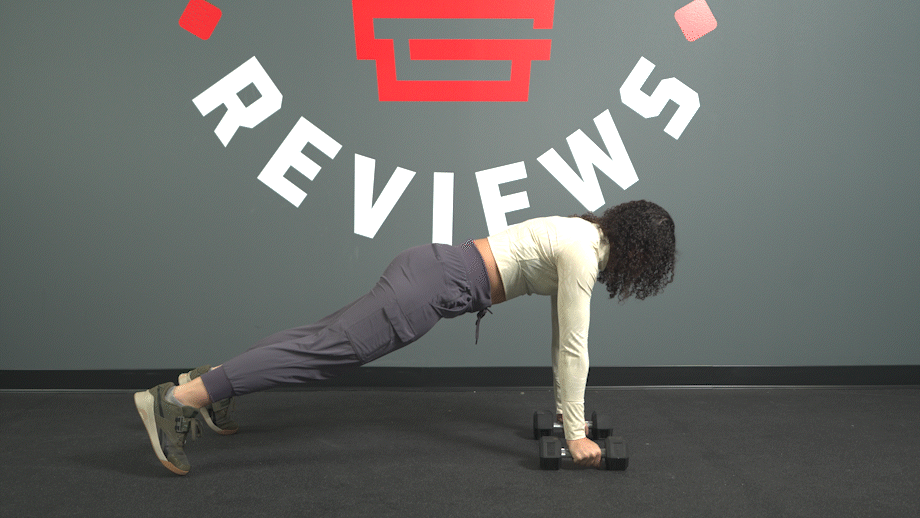
Devil’s Press
Why It’s Great: The devil’s press is great for the same reason it’s awful; it’s essentially the combination of a burpee and a dumbbell to overhead swing.
Muscles Worked: This compound movement recruits multiple muscle groups including the quads, hamstrings, glutes, and the muscles of your posterior chain.
How to Do It:
- Start in a standing position with your feet approximately shoulder-width apart and two dumbbells on the floor at your feet.
- Lower your upper body to the floor and grab your dumbbells. Jump or step your feet back as you bring your chest to the floor in between the dumbbells. This part will look nearly identical to performing a burpee.
- Push up from the floor and step or jump your feet back up to your hands, as you would during a burpee. If possible, jump your feet outside your dumbbells to make the next part easier.
- Stand, but remain hinged at the hip with your chest parallel to the floor. Swing the dumbbells behind you between your legs, as you would during a kettlebell swing, and bring them overhead in one fluid motion by driving from the hips and standing tall.
- Slowly return the dumbbells to the floor. Keep the weights and your elbows close to the body and maintain a flat back as you return to the floor to cycle into the next rep.
- Repeat as needed.
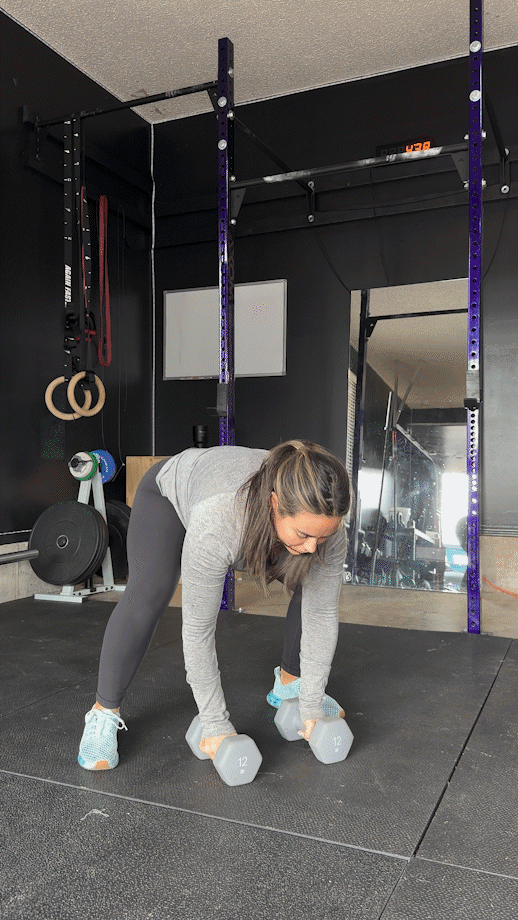
Bulgarian Split Squat w/ Farmer Hold
Why It’s Great: The Bulgarian split squat is a tough one, but it’s one of the best exercises for your legs, improves mobility, and requires little to no equipment to get in a set.
Muscles Worked: The movement itself will tax your quads, glutes, hamstrings, and calves, while the farmer’s hold component requires strong forearms, grip, and core strength to keep your balance.
How to Do It:
- Stand in front of the bench, facing away from it with a dumbbell in each hand. If you don’t have a bench, a box, step, or other elevated object will work as a substitute.
- Place one foot on the bench behind you. You want to be far enough away from the bench that your front knee makes a 90-degree angle at the bottom of the movement.
- While keeping a vertical chest, bend the knee of your planted foot and lower yourself into a squat. You will feel a stretch in the quad of your benched leg.
- Lightly tap the back knee on the ground, if possible, then come up by pressing through the front heel and extending the hip on that side.
- Repeat for desired reps and then switch sides.
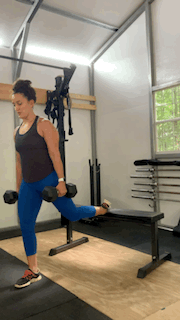
Dumbbell Farmer Carry
Why It’s Great: The dumbbell farmer’s carry, also called the “farmer’s walk,” is a classic strongman exercise that hits most major muscle groups while simultaneously providing cardio stimulus for improved conditioning.
Muscles Worked: The farmer’s carry hits nearly every muscle group in your body, providing activation to the biceps, triceps, forearms, shoulders, upper back, trapezius, quadriceps, hamstrings, calves, lower back, obliques, transverse abdominis, and rectus abdominis.
How to Do It:
- Stand with your feet hip-width apart and a dumbbell outside of each foot.
- Pick up each dumbbell with a neutral grip and stand tall with your shoulders down and back, your core tight, and your back flat.
- Maintaining a strong posture, start walking. Take small, slow steps and focus on holding your form instead of rushing through sloppily.
- Walk for the desired distance or duration.
- Carefully set down the dumbbells. Rest and repeat as needed.
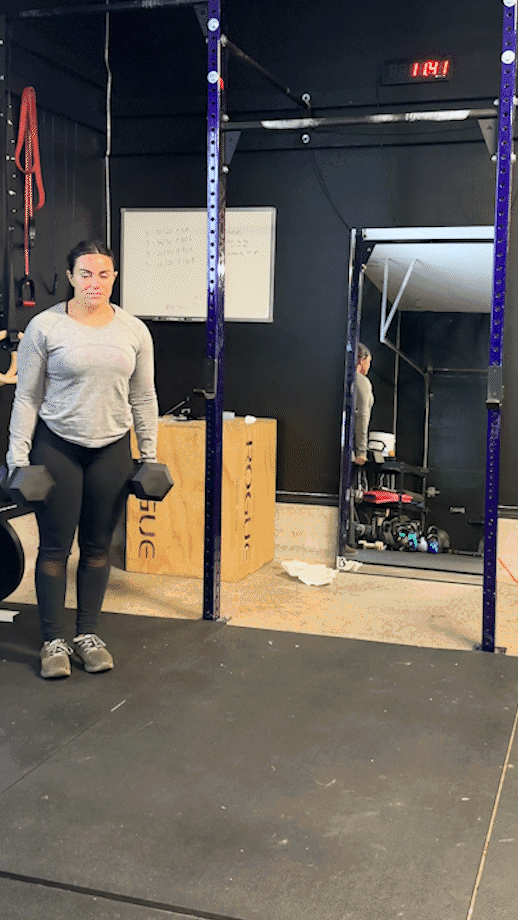
Dumbbell Pullover
Why It’s Great: The dumbbell pullover is a great movement that hits various areas of your back and chest, helping you build muscle and sculpt a great upper body.
Muscles Worked: Dumbbell pullovers mainly work the pec muscles in your chest, but they also hit the lats, teres major, triceps, serratus anterior, and anterior deltoids.
How to Do It:
- Grab a bench or something sturdy to lay on. Position yourself perpendicular to it.
- Place your upper back on the bench with your feet planted on the floor. Your thighs should be parallel to the ground and your shins should be vertical.
- Hold the end of a heavy dumbbell with both hands and hold it over your chest with your elbows bent slightly. This is your starting position.
- Take a deep breath as you lower the dumbbell by moving your arms back behind your head.
- Exhale as you slowly return to the starting position.
- Repeat as needed.
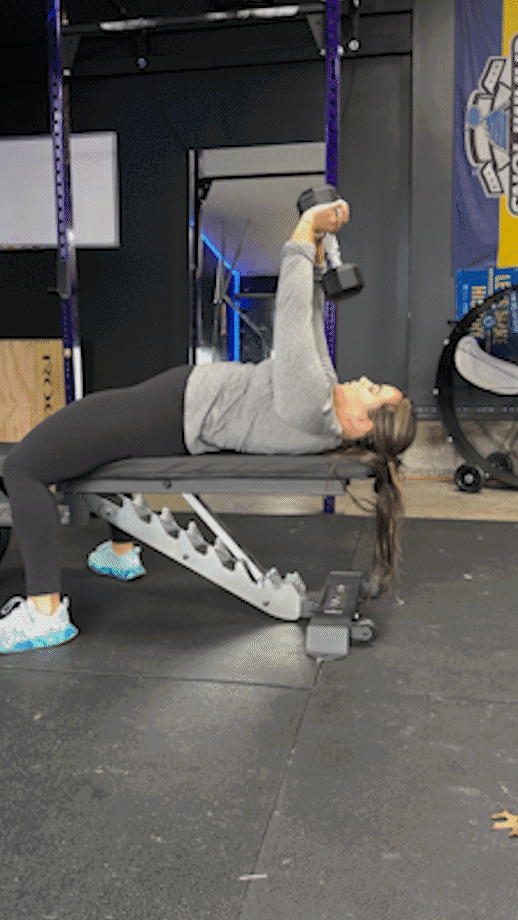
Turkish Get-Up
Why It’s Great: The Turkish get-up is an advanced technical exercise that provides a total body workout that requires slow and controlled execution, making it one of the most underrated exercises out there.
Muscles Worked: As you stand during the Turkish get-up, you’ll feel the burn in your lower body including the hip flexors, glutes, hamstrings, calves, and lower back muscles, while holding the free weight overhead will target areas like the lats and traps.
How to Do It:
- Start out lying on your back with the dumbbell in one hand. For the purposes of our instruction, we’ll use your right hand. Extend your right arm straight upwards. Extend your left arm straight out to the side on the floor, while your left leg rests extended and your right knee bends with your foot planted firmly on the floor. This is your starting position.
- Push through the right foot, coming up onto your left elbow. Continuing pushing the dumbbell upward, maintaining tension in your right arm.
- Push into the floor with your left hand, raise the hips off of the floor and bring your left leg underneath reaching a half-kneeling position on the left knee. You will have three points of contact with the floor at this time: your right foot, left knee, and left hand.
- Sit up tall in the half-kneeling position, removing your left hand from the floor. The dumbbell in your right hand should now be directly overhead pushing, similar to the end position of a shoulder press. Swing your left foot so that it is facing the same direction as the right foot.
- From this position, stand up, pushing from the right heel.
- Reverse these steps to return to the lying position, starting by stepping back into a lunge to return to a half-kneeling position. The rep is completed when you return to the starting position on the ground.
- Repeat as needed. You may complete all reps on one side before switching sides or alternate sides each rep, depending on your personal preference and goals.
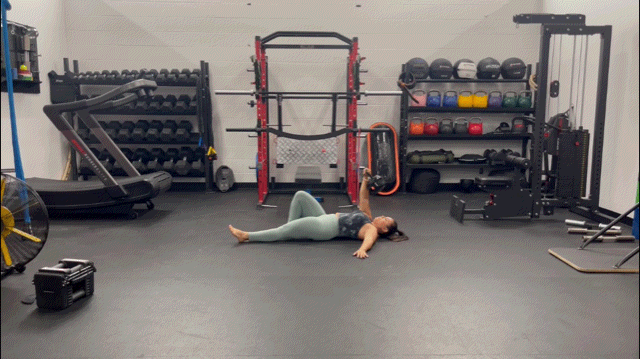
Turkish Sit-Up
Why It’s Great: While the Turkish get-up is a complicated, multi-step movement engineered to hit your whole body, the Turkish sit-up is more beginner-friendly while remaining effective.
Muscles Worked: The Turkish sit-up, while it will some of the same areas as the Turkish get-up to some degree, mostly focuses on your abdominals, especially the obliques.
How to Do It:
- Start out in the same starting position as the Turkish get-up described above.
- Same as the TGU, push through the planted foot to come up onto your elbow.
- Push with your free hand to sit almost straight up. Keep your eyes fixed on the dumbbell above as you sit up.
- Slowly return to the starting position.
- Repeat as needed. You may complete all reps on one side before switching sides or alternate sides each rep, depending on your personal preference and goals.
Dumbbell Romanian Deadlift
Why It’s Great: RDLs isolate the hip hinge, building strength in the core and lower body while simultaneously translating into explosive power for cleans, box jumps, and sports performance.
Muscles Worked: Dumbbell Romanian deadlifts are excellent for the posterior chain muscles, including the erector spinae, gluteus maximus, hamstrings, and adductors.
How to Do It:
- Stand hip-width apart with a dumbbell in each hand. Hinge at your hips with your arms fully extended to the floor and your palms facing your shins. The hinge position is your starting position for this exercise.
- Maintaining a flat back, tight core, and slightly bent knee, stand up straight. Squeeze your glutes at the end of the movement.
- Hinge forward and slowly return to the starting position.
- Repeat as needed.
RELATED: Dumbbell Leg Workout: Try These Moves For Strong Legs
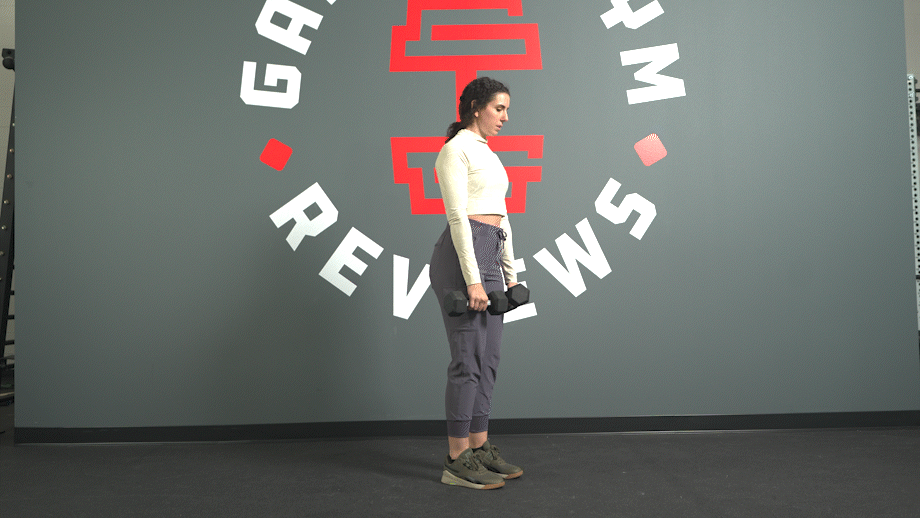
Dumbbell Sumo Deadlift
Why It’s Great: Whether you’re a seasoned deadlift pro or just getting accustomed to the tried-and-true gym staple, the dumbbell sumo deadlift provides many similar benefits while targeting the glutes in a slightly different manner.
Muscles Worked: Like standard deadlifts, dumbbell sumo deadlifts target most muscles in the posterior chain, including the lower back, glutes, and hamstrings.
How to Do It:
- Stand with feet slightly wider than shoulder-width apart, similar to a sumo wrestler squaring up with their opponent. Your dumbbells should be set in front of you on the floor.
- Rotate your feet away from the midline of your body so they’re turned out 30 to 45 degrees. Hinge at the hips, keeping your chest up and driving your hips back as you reach down to pick up the dumbbells with an overhand grip.
- Take a deep breath and tighten your core. Keep a flat back and neutral spine as you squeeze your glutes, thrust your hips forward, and raise the dumbbells, straightening your legs to stand.
- Slowly return to the starting position.
- Repeat as needed..
RELATED: The Deadlift: Muscles Worked, How To Do It, And Benefits
Goblet Cossack Squat
Why It’s Great: The gobbler Cossack squat combines the functional features of the goblet squat with the Russian Cossacks’ Dance for a unique and totally underrated leg exercise.
Muscles Worked: The goblet Cossack squat is a lower body wrecker, hitting your quads, hamstrings, glutes, and hip abductors while also activating the core, abs, and lower back.
How to Do It:
- Stand with a super wide base and your toes pointed forward. You should form a triangle with the floor. Clutch a dumbbell to your chest as you would for a standard goblet squat.
- Choose which leg to start. In our case, it will be the right leg. Shift your weight to the right leg, bending your right knee and sitting back as far as you can.
- Keep your left leg extended as you rotate your left foot onto your heel and point your toes up to the ceiling. Keep your right heel planted to the floor and your torso tall.
- After a brief pause, push back to the wide-legged starting position. Repeat the same steps for your left side.
- Repeat as needed.
21s (Front Raise, Lateral Raise, and Reverse Fly)
Why It’s Great: 21s are not just any old exercise; it’s actually a complete set of front raises, lateral raises, and reverse flies performed in succession to totally torch the upper body.
Muscles Worked: Since 21s are essentially three exercises in one comprehensive set, you’ll hit areas of the anterior deltoids, lateral deltoids, posterior deltoids, rear deltoids, trapezius, pectoralis major, and biceps.
How to Do It:
- Select two dumbbells you are able to perform 21 repetitions with (probably something pretty light). Stand with your feet shoulder-width apart with the dumbbells held in front of your body with straight arms and your palms facing you.
- Perform your front raises by lifting your arms straight up in front of your body until they are parallel with the floor. Keep your core tight, shoulders engaged, eyes facing forward, and a neutral back and neck during the movement.
- Complete 7 total front raises.
- From the starting position of your front raises, rotate your arms to the sides. Your palms will still face your body, but now the dumbbells are at your sides.
- Perform your lateral raises by lifting your arms straight up at your sides until they are parallel with the floor. Maintain a similar form as you would for your front raises with the only difference being that your arms are at your sides now instead of in front.
- Complete 7 total lateral raises.
- From the starting position of your lateral raises, hinge forward at your hips and bring your chest so it is at a 45 degree angle with the floor. Keep a flat back, neutral neck, and tight core. Bring your arms to the front of your body again and slightly bend each elbow as though you are hugging a palm tree in front of you. Your palms should now be facing each other.
- Perform your rear delt flies by lifting your arms up and out, squeezing your back and shoulder blades at the peak of the movement.
- Complete 7 total rear delt flies.
- Set down your dumbbells and rest.
RELATED: Barbells Vs. Dumbbells: The Best Option For A Home Gym
Dumbbell Thrusters
Why It’s Great: Dumbbell thrusters are a fantastic compound movement, combining everything good about dumbbell squats and overhead presses in one fluid motion.
Muscles Worked: The squat portion of the thruster will hit various muscles in your lower body, including your glutes, quads, and hamstrings, while the explosive upward motion and overhead press will recruit the core, back, triceps, and shoulders.
How to Do It:
- Standing shoulder-width apart, hold a dumbbell in each hand at shoulder height.
- Holding a tight core, lower your body into a deep squat position.
- From the bottom of your squat, push from your heels and explode back into a standing position.
- Use the force to propel the dumbbells overhead. Straighten your arms and extend your head forward so that your ears come in front of your biceps. The dumbbells should reach the overhead position due to the force generated by your legs and hips, not by pushing with your arms like a strict shoulder press.
- Squeeze your glutes at the peak of the movement.
- Lower the dumbbells back to their starting position as you cycle into the next rep fluidly.
- Repeat as needed.
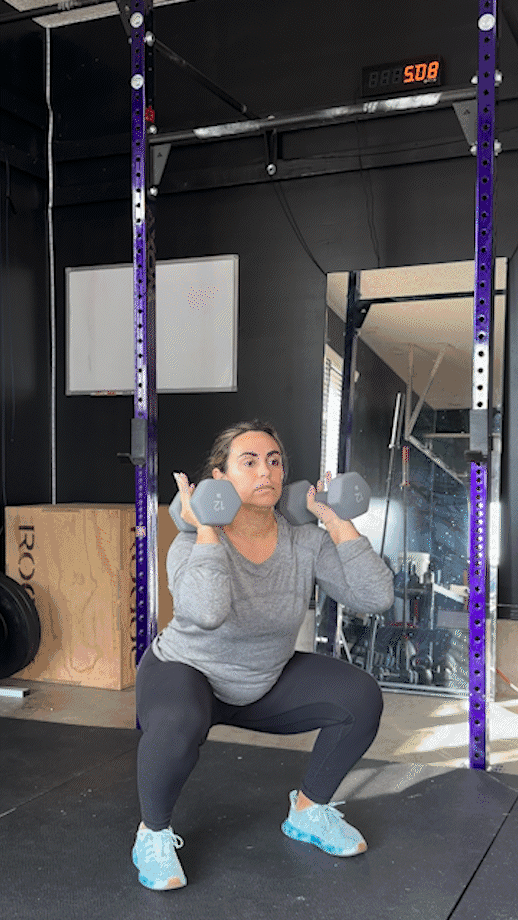
Underrated Dumbbell Exercises: Final Thoughts
We’d never advise against incorporating functional exercises like the bench press, back squat, and deadlift. As they say, however, “Variety is the spice of life.”
Work in some of our underrated dumbbell exercises to make your next workout extra spicy!
Underrated Dumbbell Exercises: Q&A
Are dumbbells better than barbells?
The barbell and rack are often the centerpiece of any workout or gym, but dumbbells are not without their upside.
Dumbbells, since they are independent satellite free weights, require using stabilizing muscles to keep them fixed on a straight bar path, while barbells, by virtue of being one piece, do some of this work for you.
In this regard, you will recruit more muscles when lifting with dumbbells, but most people are not able to lift as heavy as they do with barbells.
How many dumbbells do I need for my home gym?
When weighing which dumbbells to buy, It all depends on your personal goals and physical abilities. Some exercises use relatively light dumbbells and call for high-rep sets, while other exercises use a single heavy dumbbell held by both hands.
You could always purchase an adjustable dumbbell instead of a full set of standard dumbbells. Adjustable dumbbells provide various dumbbell weights without the need to buy a metric ton of equipment.
How heavy should I go on dumbbell exercises?
What’s light to one lifter might feel impossibly heavy to another. Combine this with the fact that some of our underrated dumbbell exercises are very unusual to perform, specifically the Turkish get-up, and going too heavy from the get go is a recipe for disaster.
We recommend starting out very light and working through the movements to feel how the exercise should be performed before adding too much weight into the mix. As you become familiar with the movements, slowly scale the weight accordingly.
When in doubt, don’t be afraid to ask a qualified personal trainer or coach!
Further reading

Our best balance boards roundup gives you an in-depth look at an interesting way to shake up your training routine. Read more

Wondering if running while pregnant is safe? Read on to find out how it affects you and baby. Read more

Looking for the best hip thrust alternatives? A personal trainer shares 11 exercises that work the same muscle groups and explains how to do them. Read more

In this Concept2 myrow review, a certified personal trainer breaks down everything you need to know about this tool created specifically for Concept2 rowers. Read more

